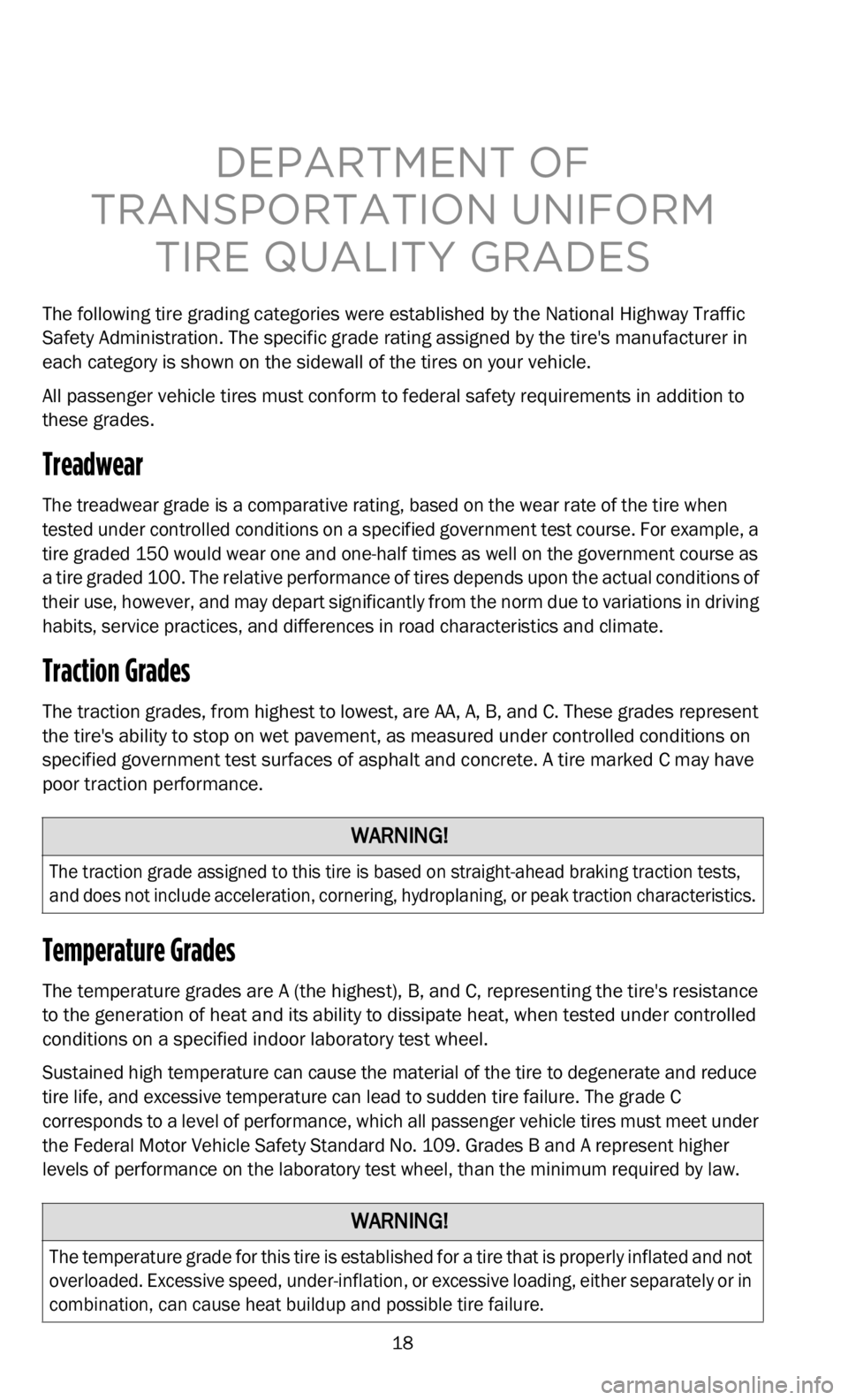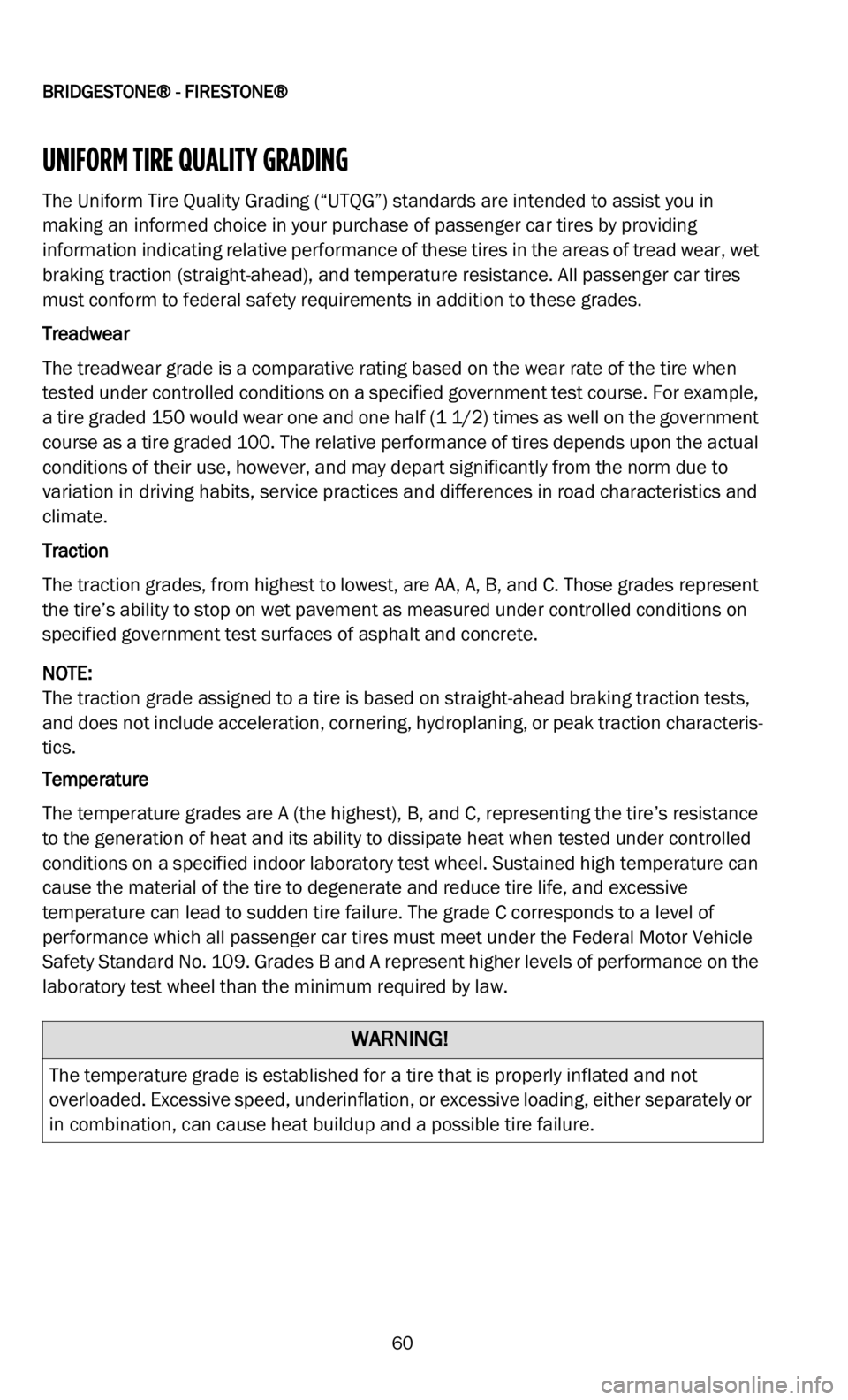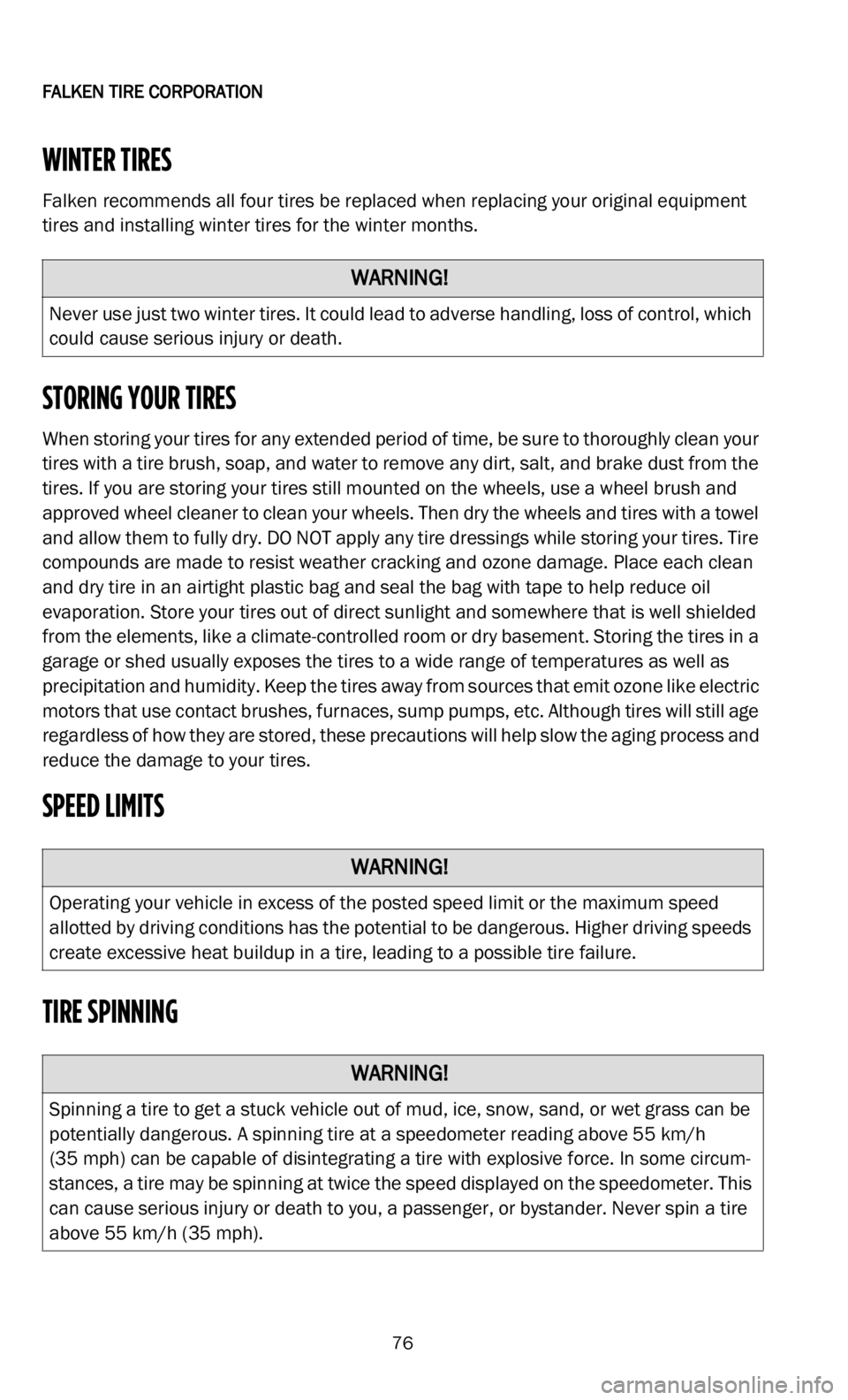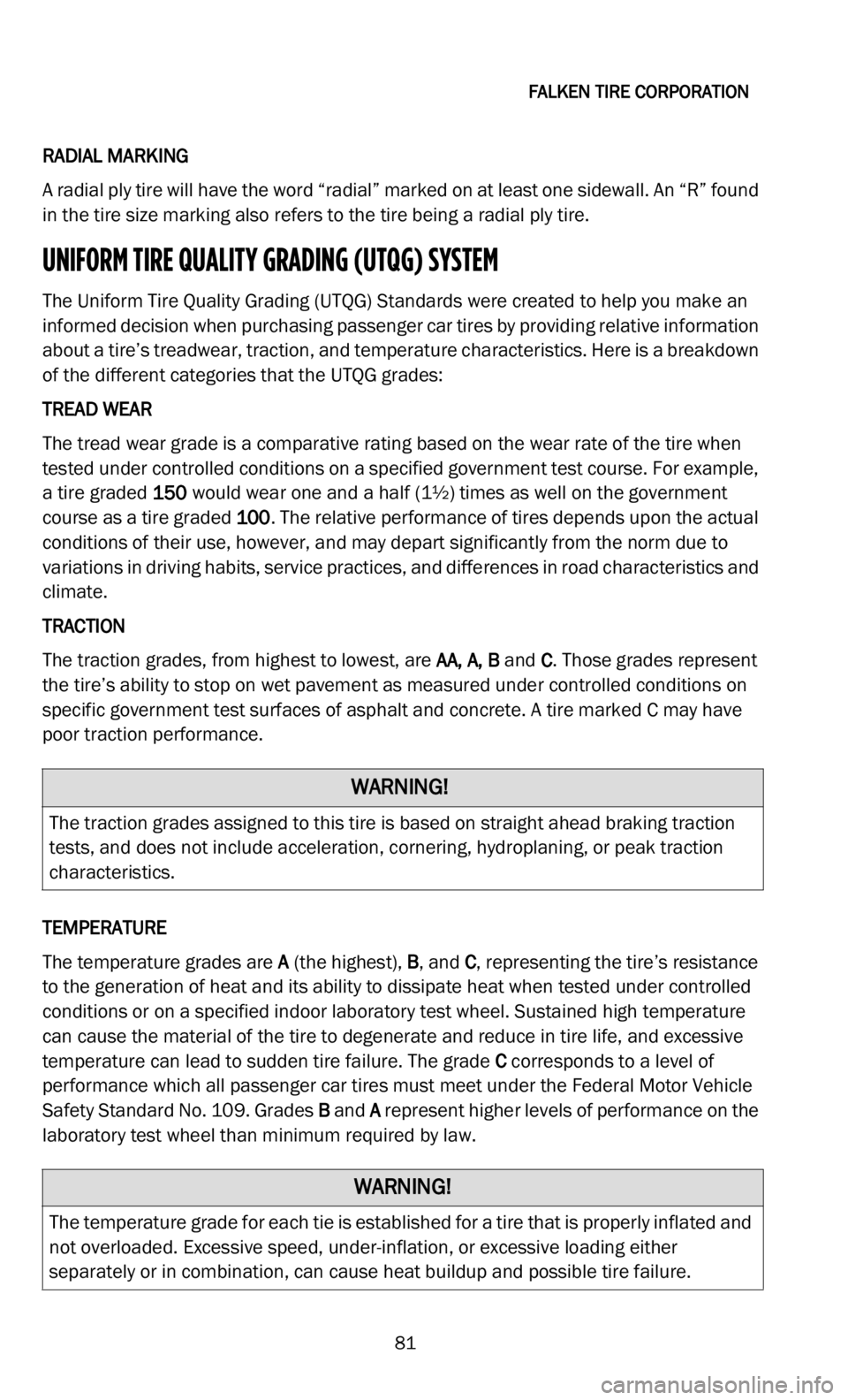climate control DODGE DURANGO 2022 Vehicle Warranty
[x] Cancel search | Manufacturer: DODGE, Model Year: 2022, Model line: DURANGO, Model: DODGE DURANGO 2022Pages: 200, PDF Size: 6.72 MB
Page 19 of 200

18
DEPARTMENT OF
TRANSPORTATION UNIFORM TIRE QUALITY GRADES
The following tire grading categories were established by the National Highway Traffic
Safety Administration. The specific grade rating assigned by the tire's manufacturer in
each category is shown on the sidewall of the tires on your vehicle.
All passenger vehicle tires must conform to federal safety requirements in addition to
the
se grades.
Treadwear
The treadwear grade is a comparative rating, based on the wear rate of the tire when
tested under controlled conditions on a specified government test course. For example, a
tire graded 150 would wear one and one-half times as well on the government course as
a tire graded 100. The relative performance of tires depends upon the actual conditions of
their use, however, and may depart significantly from the norm due to variations in driving
habits, service practices, and differences in road characteristics and climate.
Traction Grades
The traction grades, from highest to lowest, are AA, A, B, and C. These grades represent
the tire's ability to stop on wet pavement, as measured under controlled conditions on
specified government test surfaces of asphalt and concrete. A tire marked C may have
poor traction performance.
Temperature Grades
The temperature grades are A (the highest), B, and C, representing the tire's resistance
to the generation of heat and its ability to dissipate heat, when tested under controlled
conditions on a specified indoor laboratory test wheel.
Sustained high temperature can cause the material of the tire to degenerate and reduce
tir
e life, and excessive temperature can lead to sudden tire failure. The grade C
corresponds to a level of performance, which all passenger vehicle tires must meet under
the Federal Motor Vehicle Safety Standard No. 109. Grades B and A represent higher
levels of performance on the laboratory test wheel, than the minimum required by law.
WARNING!
The traction grade assigned to this tire is based on straight-ahead braking traction tests,
and does not include acceleration, cornering, hydroplaning, or peak traction characteristics.
WARNING!
The temperature grade for this tire is established for a tire that is properly inflated and not
overloaded. Excessive speed, under-inflation, or excessive loading, either separately or in
combination, can cause heat buildup and possible tire failure.
Page 61 of 200

BRIDGESTONE® - FIRESTONE®
60
UNIFORM TIRE QUALITY GRADING
The Uniform Tire Quality Grading (“UTQG”) standards are intended to assist you in
making an informed choice in your purchase of passenger car tires by providing
information indicating relative performance of these tires in the areas of tread wear, wet
braking traction (straight-ahead), and temperature resistance. All passenger car tires
must conform to federal safety requirements in addition to these grades.
Treadwear
The treadwear grade is a comparative rating based on the wear rate of the tire when
te
sted under controlled conditions on a specified government test course. For example,
a tire graded 150 would wear one and one half (1 1/2) times as well on the government
course as a tire graded 100. The relative performance of tires depends upon the actual
conditions of their use, however, and may depart significantly from the norm due to
variation in driving habits, service practices and differences in road characteristics and
climate.
Traction
The traction grades, from highest to lowest, are AA, A, B, and C. Those grades represent
t h
e tire’s ability to stop on wet pavement as measured under controlled conditions on
specified government test surfaces of asphalt and concrete.
NOTE:
The traction grade assigned to a tire is based on straight-ahead braking traction tests,
an
d does not include acceleration, cornering, hydroplaning, or peak traction characteris -
tics.
Temperature
The temperature grades are A (the highest), B, and C, representing the tire’s resistance
t o
the generation of heat and its ability to dissipate heat when tested under controlled
conditions on a specified indoor laboratory test wheel. Sustained high temperature can
cause the material of the tire to degenerate and reduce tire life, and excessive
temperature can lead to sudden tire failure. The grade C corresponds to a level of
performance which all passenger car tires must meet under the Federal Motor Vehicle
Safety Standard No. 109. Grades B and A represent higher levels of performance on the
laboratory test wheel than the minimum required by law.
WARNING!
The temperature grade is established for a tire that is properly inflated and not
overloaded. Excessive speed, underinflation, or excessive loading, either separately or
in combination, can cause heat buildup and a possible tire failure.
Page 77 of 200

FALKEN TIRE CORPORATION 76
WINTER TIRES
Falken recommends all four tires be replaced when replacing your original equipment
tires and installing winter tires for the winter months.
STORING YOUR TIRES
When storing your tires for any extended period of time, be sure to thoroughly clean your
tires with a tire brush, soap, and water to remove any dirt, salt, and brake dust from the
tires. If you are storing your tires still mounted on the wheels, use a wheel brush and
approved wheel cleaner to clean your wheels. Then dry the wheels and tires with a towel
and allow them to fully dry. DO NOT apply any tire dressings while storing your tires. Tire
compounds are made to resist weather cracking and ozone damage. Place each clean
and dry tire in an airtight plastic bag and seal the bag with tape to help reduce oil
evaporation. Store your tires out of direct sunlight and somewhere that is well shielded
from the elements, like a climate-controlled room or dry basement. Storing the tires in a
garage or shed usually exposes the tires to a wide range of temperatures as well as
precipitation and humidity. Keep the tires away from sources that emit ozone like electric
motors that use contact brushes, furnaces, sump pumps, etc. Although tires will still age
regardless of how they are stored, these precautions will help slow the aging process and
reduce the damage to your tires.
SPEED LIMITS
TIRE SPINNING
WARNING!
Never use just two winter tires. It could lead to adverse handling, loss of control, which
could cause serious injury or death.
WARNING!
Operating your vehicle in excess of the posted speed limit or the maximum speed
allotted by driving conditions has the potential to be dangerous. Higher driving speeds
create excessive heat buildup in a tire, leading to a possible tire failure.
WARNING!
Spinning a tire to get a stuck vehicle out of mud, ice, snow, sand, or wet grass can be
potentially dangerous. A spinning tire at a speedometer reading above 55 km/h
( 3
5 mph) can be capable of disintegrating a tire with explosive force. In some circum -
stances, a tire may be spinning at twice the speed displayed on the speedometer. This
c a
n cause serious injury or death to you, a passenger, or bystander. Never spin a tire
above 55 km/h (35 mph).
Page 82 of 200

FALKEN TIRE CORPORATION
81
RADIAL MARKING
A radial ply tire will have the word “radial” marked on at least one sidewall. An “R” found
i n
the tire size marking also refers to the tire being a radial ply tire.
UNIFORM TIRE QUALITY GRADING (UTQG) SYSTEM
The Uniform Tire Quality Grading (UTQG) Standards were created to help you make an
informed decision when purchasing passenger car tires by providing relative information
about a tire’s treadwear, traction, and temperature characteristics. Here is a breakdown
of the different categories that the UTQG grades:
TREAD WEAR
The tread wear grade is a comparative rating based on the wear rate of the tire when
te
sted under controlled conditions on a specified government test course. For example,
a tire graded 150 would wear one and a half (1½) times as well on the government
course as a tire graded 100. The relative performance of tires depends upon the actual
conditions of their use, however, and may depart significantly from the norm due to
variations in driving habits, service practices, and differences in road characteristics and
climate.
TRACTION
The traction grades, from highest to lowest, are AA
, A, B and C. Those grades represent
the tire’s ability to stop on wet pavement as measured under controlled conditions on
specific government test surfaces of asphalt and concrete. A tire marked C may have
poor traction performance.
TEMPERATURE
The temperature grades are A
(the highest), B, and C, representing the tire’s resistance
to the generation of heat and its ability to dissipate heat when tested under controlled
conditions or on a specified indoor laboratory test wheel. Sustained high temperature
can cause the material of the tire to degenerate and reduce in tire life, and excessive
temperature can lead to sudden tire failure. The grade C corresponds to a level of
performance which all passenger car tires must meet under the Federal Motor Vehicle
Safety Standard No. 109. Grades B and A represent higher levels of performance on the
laboratory test wheel than minimum required by law.
WARNING!
The traction grades assigned to this tire is based on straight ahead braking traction
tests, and does not include acceleration, cornering, hydroplaning, or peak traction
characteristics.
WARNING!
The temperature grade for each tie is established for a tire that is properly inflated and
not overloaded. Excessive speed, under-inflation, or excessive loading either
separately or in combination, can cause heat buildup and possible tire failure.
Page 192 of 200

TOYO TIRES® – LIMITED WARRANTY
191
The relative performance of the tires depends upon the actual conditions of their use
and may vary due to driving habits, service practices, differences in road characteris -
tics, and climate.
• T raction - The traction grades from highest to lowest are AA, A, B, and C, and they
r
epresent the tire’s ability to stop on wet pavement as measured under controlled
conditions on specified government test surfaces of asphalt and concrete.
NOTICE: (TBL IN FINAL PUBLISH)
The traction grade assigned to tires is based on locked braking (straight ahead) traction
te
sts and does not include cornering (turning) traction.
• T emperature - The temperature grades are A (the highest), B, and C, representing the
t
ire’s resistance to the generation of heat and its ability to dissipate heat when tested
under controlled conditions on a specified indoor laboratory test wheel. Sustained
high temperatures can cause the materials of the tire to degenerate and reduce tire
life, and excessive temperature can lead to sudden tire failure. The grade C corre -
sponds to a level of performance that all passenger car tires must meet under the
F e
deral Motor Vehicle Safety Standard No. 139. Grades B and A represent higher
levels of performance on the laboratory test wheel than the minimum required by law.
• D OT Quality Grades - All passenger car tires must conform to federal requirements in
a
ddition to these grades.
WARNING!
The temperature grade is established for a tire that is properly inflated and not
overloaded. Excessive speed, underinflation, or excessive loading either separately or
in combination can cause heat buildup and possible tire failure. This can cause an
accident, which could lead to serious personal injury or death.